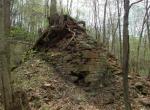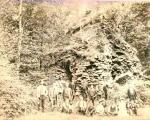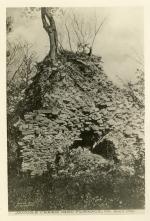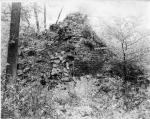![header=[Marker Text] body=[First furnace west of the Alleghenies. Built 1789 on banks of nearby Jacob's Creek, its ruins are still observable. Supplied iron for Wayne's campaign in 1794 against the Indians. ] sign](http://explorepahistory.com/kora/files/1/10/1-A-2A1-139-ExplorePAHistory-a0k1r9-a_450.jpg)
Mouse over for marker text
Name:
Alliance Furnace
Region:
Laurel Highlands/Southern Alleghenies
County:
Fayette
Marker Location:
SR 1002, about 6 miles NW of Pa. 819, Perryopolis
Dedication Date:
November 22, 1946
Behind the Marker
Alliance Furnace was one of the earliest furnaces west of the Alleghenies. Three blast furnaces appeared about the same time in Fayette County, including Fairfield Furnace and Union Furnace. Sources vary as to the date of Alliance Furnace, but Turnbull, Marmie and Company constructed it as early as 1789 and put it into blast between 1790 and 1792.
Prior to building Alliance Furnace, William Turnbull, Peter Marmie and John Holker had established this mercantile firm in Philadelphia and Pittsburgh. They had built a distillery, saw mill and salt works on the Beaver River, and expanded their western Pennsylvania enterprises to include the iron furnace. William Turnbull had been a purchasing agent and commissary for Pennsylvania soldiers during the American Revolution. Holker had come to America during the Revolution as Consul General of France and as Agent General to the French navy. Peter Marmie also had arrived during the war from France, where he had worked with Holker. Marmie managed the firm's business at the iron furnace and lived not far away in Westmoreland County.
Marmie became the stuff of legend at Alliance Furnace. Local legend had it that he crossed the Alleghenies with the pomp of a nobleman, with silver shoes on his horse's hoofs. Local tradition also claimed that "Marmie, the sporting Frenchman, committed suicide by jumping into the burning furnace, after driving his dogs of the chase before him." However, historical fact tells otherwise. Marmie died of natural causes in 1823, long after the furnace closed. Marmie was one of several ironmasters who supposedly threw themselves and their hunting dogs into the fiery blast of Pennsylvania iron furnaces.
Unlike Marmie, Alliance Furnace met an early end. After going into blast, it produced pots, kettles and other hollowware that settlers in the area needed to cook and process food. It also made cannon shot and shell for General Anthony Wayne's troops in their campaign against Native Americans, which secured western Pennsylvania for white settlement in 1795 after the Battle of Fallen Timbers in Ohio. However, by 1793, Turnbull, Marmie and Holker suffered severe financial straits at Alliance Furnace, including not receiving payment for war materials they produced for France. In 1797 Turnbull sold his share of the furnace to Holker. In 1802 the furnace went out of blast forever.
Although Alliance Furnace did not last long, it was significant as one of the first furnaces west of the Alleghenies. Fayette County was the early center of the iron industry in the region because it lay in the path of settlement into western Pennsylvania. Settlers demanded pots, horseshoes, nails, and many other iron products, but iron was often in short supply on the frontier. Settlers even burned abandoned structures to salvage iron nails with which they could build homes. Fayette County also had abundant forests that provided charcoal, ready sources of iron ore and limestone, and streams for water power. By 1800, ironmasters had built sixteen iron works in Fayette County, and another three in Allegheny, Greene and Westmoreland counties.
The iron industry continued to expand in western Pennsylvania during the early nineteenth century as a growing population demanded iron and Pittsburgh developed as a gateway to the west. By 1811 Fayette County had twenty-seven works that supplied iron products to Pittsburgh as well as the Ohio and Mississippi valleys and beyond. During this period Pittsburgh became the western Pennsylvania center for secondary iron works, including forges, foundries, rolling mills, and naileries that fashioned a broad range of products from iron supplied by furnaces primarily in Fayette County and the Juniata Iron region.
Juniata Iron region.
In 1817 Isaac Meason opened one of the first rolling mills at Plumsock (seeopened one of the first rolling mills at Plumsock. As population and demand continued to expand in western Pennsylvania, so did the iron industry. By 1850 the region had 140 iron furnaces, forges and rolling mills, with concentrations especially in the "iron city" of Pittsburgh, and Clarion, Venango, Armstrong and Mercer counties. Of the region's 114 iron furnaces, 103 were charcoal furnaces. Significantly, in 1850 eleven of the furnaces used bituminous coal or coke, anticipating the region's later shift from charcoal to bituminous coal and coke for fuel.
Isaac Meason opened one of the first rolling mills at Plumsock (seeopened one of the first rolling mills at Plumsock. As population and demand continued to expand in western Pennsylvania, so did the iron industry. By 1850 the region had 140 iron furnaces, forges and rolling mills, with concentrations especially in the "iron city" of Pittsburgh, and Clarion, Venango, Armstrong and Mercer counties. Of the region's 114 iron furnaces, 103 were charcoal furnaces. Significantly, in 1850 eleven of the furnaces used bituminous coal or coke, anticipating the region's later shift from charcoal to bituminous coal and coke for fuel.
Prior to building Alliance Furnace, William Turnbull, Peter Marmie and John Holker had established this mercantile firm in Philadelphia and Pittsburgh. They had built a distillery, saw mill and salt works on the Beaver River, and expanded their western Pennsylvania enterprises to include the iron furnace. William Turnbull had been a purchasing agent and commissary for Pennsylvania soldiers during the American Revolution. Holker had come to America during the Revolution as Consul General of France and as Agent General to the French navy. Peter Marmie also had arrived during the war from France, where he had worked with Holker. Marmie managed the firm's business at the iron furnace and lived not far away in Westmoreland County.
Marmie became the stuff of legend at Alliance Furnace. Local legend had it that he crossed the Alleghenies with the pomp of a nobleman, with silver shoes on his horse's hoofs. Local tradition also claimed that "Marmie, the sporting Frenchman, committed suicide by jumping into the burning furnace, after driving his dogs of the chase before him." However, historical fact tells otherwise. Marmie died of natural causes in 1823, long after the furnace closed. Marmie was one of several ironmasters who supposedly threw themselves and their hunting dogs into the fiery blast of Pennsylvania iron furnaces.
Unlike Marmie, Alliance Furnace met an early end. After going into blast, it produced pots, kettles and other hollowware that settlers in the area needed to cook and process food. It also made cannon shot and shell for General Anthony Wayne's troops in their campaign against Native Americans, which secured western Pennsylvania for white settlement in 1795 after the Battle of Fallen Timbers in Ohio. However, by 1793, Turnbull, Marmie and Holker suffered severe financial straits at Alliance Furnace, including not receiving payment for war materials they produced for France. In 1797 Turnbull sold his share of the furnace to Holker. In 1802 the furnace went out of blast forever.
Although Alliance Furnace did not last long, it was significant as one of the first furnaces west of the Alleghenies. Fayette County was the early center of the iron industry in the region because it lay in the path of settlement into western Pennsylvania. Settlers demanded pots, horseshoes, nails, and many other iron products, but iron was often in short supply on the frontier. Settlers even burned abandoned structures to salvage iron nails with which they could build homes. Fayette County also had abundant forests that provided charcoal, ready sources of iron ore and limestone, and streams for water power. By 1800, ironmasters had built sixteen iron works in Fayette County, and another three in Allegheny, Greene and Westmoreland counties.
The iron industry continued to expand in western Pennsylvania during the early nineteenth century as a growing population demanded iron and Pittsburgh developed as a gateway to the west. By 1811 Fayette County had twenty-seven works that supplied iron products to Pittsburgh as well as the Ohio and Mississippi valleys and beyond. During this period Pittsburgh became the western Pennsylvania center for secondary iron works, including forges, foundries, rolling mills, and naileries that fashioned a broad range of products from iron supplied by furnaces primarily in Fayette County and the
In 1817








